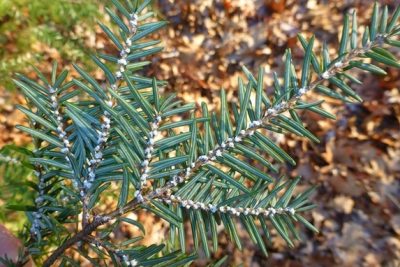Adelges tsuga
The hemlock woolly adelgid (HWA) is a serious pest of Canadian or Eastern hemlock, Tsuga canadensis, in the northeastern states. This insect was discovered in Connecticut in 1985 and has spread rapidly to both cultivated and forest hemlocks.
Adelgids are small, soft-bodied insects that are closely related to aphids. They have piercing-sucking mouthparts, which are inserted to remove plant sap for food. The HWA feeds primarily on young branches causing cessation of tree growth, discoloration and premature drop of needles, dieback of branches and possible death of the tree in as little as one year.

Life Cycle
The females are oval, blackish-gray, about 2mm in length and serve as the over-wintering stage. The brownish-orange, very small, oblong eggs are laid in cottony white egg sacs (about 50 eggs per sac) on young twigs from late March to May. The presence of the egg sacs offers the most visible diagnostic evidence of a HWA infection. The eggs hatch into reddish-brown crawlers (nymphs) from early April through early June and begin feeding on the sap of young twigs, maturing into adults in a few weeks. Some of the adults are wingless and remain on hemlock for a second generation, while the winged forms may fly to nearby hemlocks or spruces.
None of the common native and exotic spruces appear to be suitable for the winged HWA to complete its life cycle. Second generation crawlers initially feed on new twigs during July but become dormant in late summer through early autumn. Crawlers resume feeding in mid-October and develop into the over-wintering adults. They feed all winter and mature by spring.
Pest Management and Control
Chemical
Infestations of the HWA can be detected early by periodically examining young twigs for the presence of the egg sacs. They are readily observed in the spring before the eggs have hatched. Keep in mind that remnants of old egg sacs may remain on twigs long after the eggs have hatched and the insect has been controlled. Early detection is very important because injury to hemlock may develop quickly. That is why periodic examinations are an important practice in the control of the HWA.
Several insecticides are available that will provide excellent HWA control; however, insecticides should not be applied on a preventive basis. Many of the hemlocks in Connecticut will not be infested and will not need treating. Controls should be applied only when HWA infestations are observed.
An excellent time to control HWA infestation is from July through September after the eggs have hatched and the young adelgids are relatively unprotected. Summer oil and insecticidal soap have been found to provide excellent control with one application, provided complete coverage is made in this time period. Both insecticides kill only by direct contact. Thorough coverage with a drenching spray is essential for control. An all-season Horticulture oil is effective for HWA control when applied in April to mid-May. It will also control scale insects and mites at the same time.
Biological
Sasajiscymnus tsugae is a predatory ladybird beetle that is native to Japan and is available commercially in the US. A federal permit for the release of S. tsugae for biological control of the hemlock woolly adelgid in Connecticut was issued in April 1995 and the first release of S. tsugae occurred in a town park in Windsor, Connecticut that spring. The life cycle of S. tsugae is very close to the hemlock wooly adelgid's cycle. Both insects have two generations each year, adult beetles overwinter, and spring egg laying by the adult S. tsugae normally coincides with peak egg laying and hatching of overwintering adelgids. A second generation of beetles occurs in June around the time that the second generation of adelgids appears. Adult ladybugs are able to survive by feeding on dormant young adelgids. S. tsugae larvae and adults will feed on all stages of hemlock woolly adelgid available.
Despite good cultural practices, pests and diseases at times may appear. Chemical control should be used only after all other methods have failed.
For pesticide information or other questions please call toll free: 877-486-6271.
Revised by UConn Home and Garden Education Center 2016.